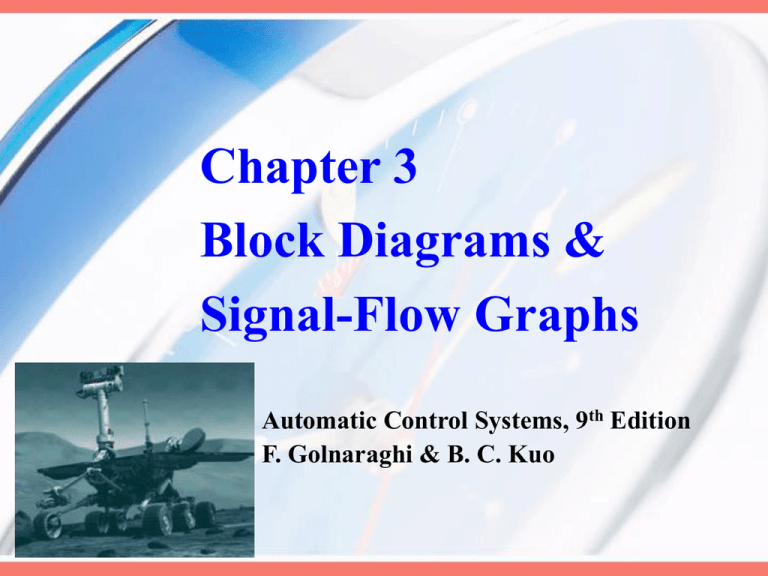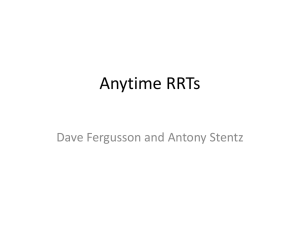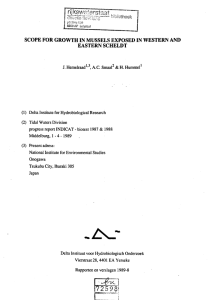Section 3
advertisement

Chapter 3 Block Diagrams & Signal-Flow Graphs Automatic Control Systems, 9th Edition F. Golnaraghi & B. C. Kuo Section 3- 0, p. 104 Main Objectives of This Chapter 1. To study block diagrams, their components, and their underlying mathematics. 2. To obtain transfer function of systems through block diagram manipulation and reduction. 3. To introduce the signal-flow graphs. 4. To establish a parallel between block diagrams and signal-flow graphs. 5. To use Marson’s gain formula for finding transfer function of systems. 6. To introduce state diagrams. 7. To demonstrate the Matlab tools using case studies. 3-1 Section 3- 1, p. 104 3-1 Block Diagrams • Block diagrams: the composition and interconnection of the components of a system describe the cause-and-effect relationships throughout the system. Disturbance Input actuator Output Error comparator 3-2 Section 3- 1, p. 105 DC-Motor Control System (Fig. 3.2) system components (a) Block diagram of a dc-motor control system. linear range (b) Block diagram with transfer function and amplifier characteristic. 3-3 Section 3- 1, p. 106 Typical Elements of Block Diagrams in Control Systems comparator feedback loop Typical block elements: plant, controller, actuator, and sensor 3-4 Section 3- 1, p. 107 Block-Diagram Elements of Comparators (a) Addition (b) Subtraction (c) Addition and subtraction Fig. 3-4 Block diagram elements of typical sensing devices of control systems. 3-5 Section 3- 1, p. 107 Time & Laplace Domain Block Diagrams • Example 3-1-1: 3-6 Section 3- 1, p. 108 Example 3-1-2 3-7 Section 3- 1, p. 109 Linear Feedback Control System reference input (command) actuating signal output (controlled variable) feedback signal Y (s) G(s) R(s) G(s) H (s)Y (s) Negative feedback: Positive feedback: 3-8 Section 3- 1, p. 110 Relation between Mathematical Equations & Block Diagram • The second-order prototype system: Figure 3-9 Figure 3-10 3-9 Section 3- 1, p. 111 Relation between Mathematical Equations & Block Diagram (cont.) 3-10 Section 3- 1, p. 112 Example 3-1-3 Find the transfer function of the system in Fig. 3-12. Sol: 3-11 Section 3- 1, p. 112 Example 3-1-3 (cont.) 3-12 Section 3- 1, p. 112 Example 3-1-4 Find V(s)/U(s) = ? Sol: 1 X ( s) V ( s) s 3-13 Section 3- 1, p. 113 Block Diagram Reduction: Moving a Branch Point • Moving a branch point from P to Q: 3-14 Section 3- 1, p. 114 Block Diagram Reduction: Moving a Comparator 3-15 Section 3- 1, p. 114 Example 3-1-5 3-16 Section 3- 1, p. 115 Example 3-1-5 (cont.) G1G2 H1 Y (s) R(s) 3-17 Section 3- 1, p. 116 Block Diagram of Multi-input Systems Special Case: Systems with a Disturbance Disturbance Reference input • Super Position: • 3-18 Section 3- 1, p. 117 Super Position 3-19 Section 3- 1, p. 117 Multivariable Systems Block diagram: Feedback control system: 3-20 Section 3- 1, p. 118 Example 3-1-6 Sol: 3-21 Section 3- 2, p. 119 3-2 Signal-Flow Graphs (SFGs) • Input-output (cause-and effect) relations: branch gain • Basic elements of an SFG: output input A signal can transmit through a branch only in the direction of the arrow. 3-22 Section 3- 2, p. 120 Example 2-3-1 Construction of an SFG: step-by-step 3-23 Section 3- 2, p. 121 Definition of SFG Terms (1/3) Input node (Source): only outgoing branches, e.g., in Fig. 3-26 Output node (Sink): only incoming branches, e.g., in Fig. 3-26 • We can make any noninput node of an SFG an output. • We cannot convert a noninput node into an input node. 3-24 Section 3- 2, p. 122 Definition of SFG Terms (2/3) • Path: any connection of a continuous succession branches traversed in the same direction, e.g., y1– y2– y3 or y2– y3–y2. • Forward Path: a path that starts at an input node and ends at an output node and along which no node is traversed more than once. • Path Gain: the product of the branch gains encountered in traversing a path, e.g., path = y1– y2– y3 – y4 path gain = a12a23a34 • Forward-Path Gain: the path gain for a forward gain. 3-25 Section 3- 2, p. 122 Definition of SFG Terms (3/3) • Loop: a path that originates and terminates on the same node and along which no other node is encountered more than once. • Loop Gain: the path gain of a loop. • Nontouching Loops: they do not share a common node. Nontouching Loops 3-26 Section 3- 2, p. 123 SFG Algebra • the sum of all signals entering the node • transmit through all branches leaving the node • Parallel branches: 3-27 Section 3- 2, p. 124 SFG Algebra & Feedback Control • Series connection: • SFG of a Feedback Control System: U (s) 3-28 Section 3- 2, p. 125 Relation between Block Diagram & SFGs 3-29 Section 3- 2, p. 125 Gain Formula for SFG • Mason’s gain formula: Lmr= gain product of the mth possible combination of r nontouching loops = 1 (sum of the gains of all individual loops) + (sum of products of gains of all possible combinations of two nontouching loops) (sum of products of gains of all possible combinations of three nontouching loops) + + … k = the for that part of the SFG that is nontouching with the kth forward path 3-30 Section 3- 2, p. 126 Example 3-2-2 • Y(s) / R(s) = ? 3-31 Section 3- 2, p. 126 Example 3-2-3 y5 / y1 = ? • Three forward paths: • Four loops: • One pair of nontouching loops: • 3-32 Section 3- 2, p. 126 Example 3-2-3 (cont.) 3-33 Section 3- 2, p. 127 Example 3-2-4 3-34 Section 3- 2, p. 128 Gain Formula between Output Node and Noninput Nodes & Example 3-2-5 Example 3-2-5: 3-35 Section 3- 2, p. 128 Application of Gain Formula to Block Diagram 3-36 Section 3- 2, p. 129 Example 3-2-6 3-37 Section 3- 2, p. 129 Simplified Gain Formula • All loops and forward paths are touching: • Example: 3-38










